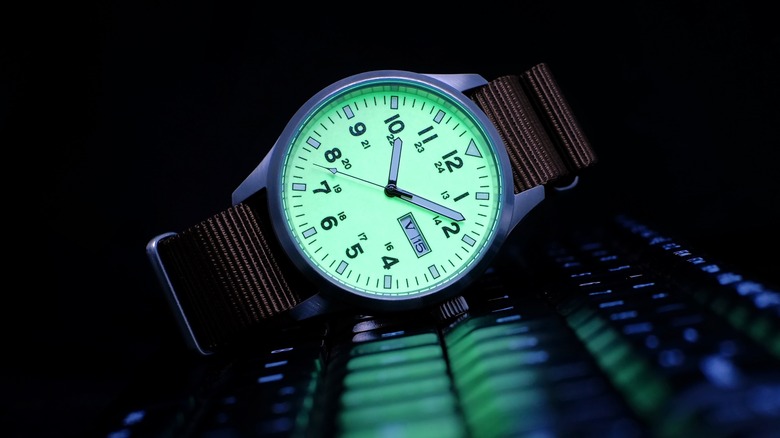A Brief History Of Indiglo Electroluminescence Tech (And How It Works)
Today it's commonplace to look at your phone in the dark and not realize that the brightness is cranked all the way up, totally irritating your retina. But there was a time when portable gadgets like the Game Boy didn't light up, and you needed another light source to realize your character just died. Indiglo Electroluminescence is one of the innovations that made the world just a little brighter with its faint, underwater-looking blue-green glow.
The technology was popularized by Timex in 1992 and made huge blue-green waves, though it actually dates back decades. According to the Edison Tech Center, it was scientist Georges Destriau, an associate of Marie Curie, who coined the term Electroluminescence in 1936 as he was working on phosphorescent ZnS powders. Lighting company Sylvania took the developing technology commercial in the mid-fifties when they released night lights, clock radios, military tech displays, and automobile dashboards with what they termed "Panelescent" lighting, which emitted a soft green glow.
[Featured image by Chrononautix via Wikimedia Commons | Cropped and scaled |CC BY-SA 4.0]
The Timex Indiglo watch and how it works
So in 1992, when Timex announced in an ad that "Until now, watches were really hard to read in the dark," they were telling the truth, for the most part. The little (occasionally sticky) button instantly lit up the little digital display and made wearers feel cool, like they were on a secret mission, though that mission seemed to involve telling the time mostly.
The Indiglo name was later licensed to numerous other companies like Austin Innovations for an array of products, including clocks, night lights, personal organizers, and pretty much any device that was hard to read in the dark. It was clearly a game changer in the market, and a much better alternative to previous use of radium to light up displays, which made seeing the time not quite worth the inherent radioactive dangers.
At a basic level, electroluminescence is simply the manipulation of electricity into light, so in the case of Indiglo, an electrical current energizes a thin layer of phosphorescent material and produces light. Since the technology uses only a couple of milliwatts of power from the tiny battery inside, that button can typically be pressed over and over again (within reason). The technology is a stark contrast to an incandescent bulb, which uses heat to produce light and cannot be flattened out like electroluminescence for use in a watch. That would be a big watch.

